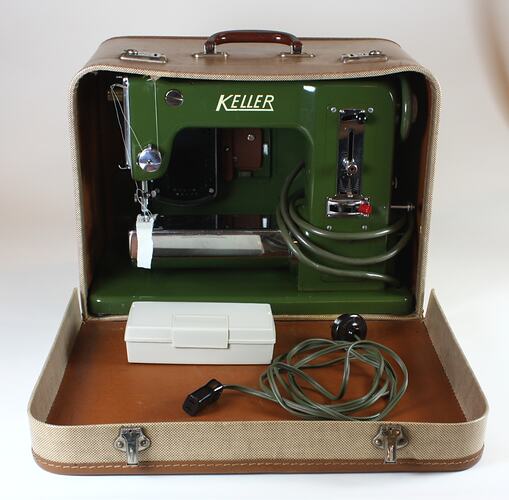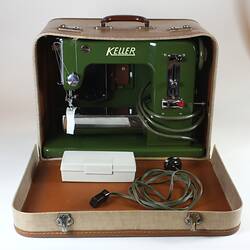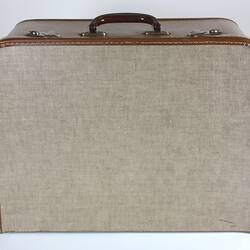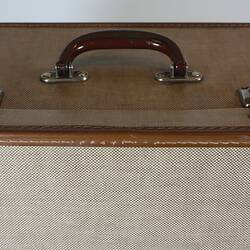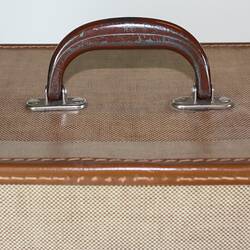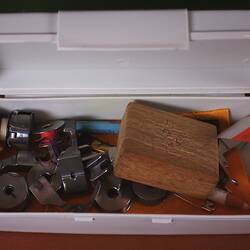Summary
'Keller' brand sewing machine in its original case brought to Australia by Dorothea Dunzinger [formerly Huber and nee Freitag] when she migrated from Austria to Melbourne in 1959. Dorothea was a proficient seamstress in Europe and had also made some of her own clothes. From the day she arrived in Australia she used this sewing machine for family sewing and also to undertake clothing alterations for the families with whom she boarded. When Dorothea owned her own boutique in Camberwell she used the sewing machine to alter clothing for customers and it became a secondary machine for her later outwork in Kalorama and Montrose. It became one of three industrial machines she owned - two sewing machines and one overlocker.
Born in 1929 near Graz, Austria, Dorothea was a proficient recreational skier and part of a volunteer rescue team in Switzerland. She lived and worked primarily as a mill weaver and seamstress in England, Switzerland and Austria before migrating to Australia from Austria on 30 November 1959, arriving on the Cogedar Line ship 'Flaminia' on 31 December. She settled in Melbourne and married fellow Austrian Johann Dunzinger whom she met at Broadmeadows migrant hostel. They had a daughter Caroline and lived in various Melbourne suburbs boarding and renting before building a home in Kalorama. The couple divorced in1978. Dorothea worked hard all her life, owning a boutique clothing shop in Camberwell at one stage but primarily as a textile outworker and factory worker trying to make ends meet. She died in 2001.
Physical Description
Enamelled metal electric sewing machine with accessories and case. The sewing machine consists of a main body with enclosed motor, detachable electric treadle pedal with electrical cord in green and brown. The sewing machine is a deep forest green colour, with the brand name 'KELLER' painted in cream paint across the top . There is a spool of white cotton threaded through the machine, and a small piece of cream jersey knit material set under the needle. There is a stitch selector panel in unpainted metal set into the righ hand pillar of the machine, with options for zig zag or ruinning stitches, and a selector for stitch width and length made from silver metal with a red plastic end.. Within the sewing machine case is a cream plastic snap lock containier holding six spare sewing feet, one spare button hole sewing foot, seven spare bobbins, one safety pin, one piece of yellow jersey knit fabric, one block of wood, one pale blue dressmaker's pencil and one white dressmaker's pencil. The custom case is covered in a woven plastic material in brown and cream, with a painted metal handle and two metalloacks at the top.The case opens via two locks on the top, with the lid of the suitcase opening out to reveal the upright sewing machine within. The sewing machine is secured to the case by a metal locking machanism which is built into the back of the case.
Significance
The Dunzinger Austrian Migrant Collection has evolved to become a rich group of objects which tell a particular story of an Austrian woman's post-war migration experiences, as well as broader contextual narratives relating to the variety of selection and management processes in place in Europe after World War II. These include references to Australian-specific organisations involved in migration management such as the Australian Migration Mission. Items explore the enthusiastic promotional activities of the Australian Government to encourage migration from the UK and Europe in order to populate Australia and build a workforce. Artefacts also relate to a significant Italian migrant ship of the period, the Cogedar Line 'Flotto Lauro'. There are also personal domestic items, clothing, needlecraft, and other personal items brought to Australia making this a well-rounded collection tracing a personal narrative from departure, journey, arrival and early settlement.
There is a also symbolic poignancy about the skis, ski clothing and rucksack, and the small sewing machine Dorothea Dunzinger brought with her from Austria. The skis represent precious mementoes from home and hopes and expectations for the leisure activity they might bring in Australia; the sewing machine a pragmatic object which came to dominate Dorothea's actual settled life of hard work both in the home and as an outworker with no leisure time at all.
More Information
-
Collecting Areas
-
Acquisition Information
Donation from Ms Caroline Dunzinger, 07 Nov 2012
-
Past Owner & User
Mrs Dorothea Dunzinger, Melbourne, Victoria, Australia, 1950s
-
Inscriptions
One sewing machine, painted: 'KELLER'
-
Classification
-
Category
-
Discipline
-
Type of item
-
Overall Dimensions
400 mm (Width), 205 mm (Depth), 285 mm (Height)
Dimensions for sewing machine.
-
Overall Dimensions
430 mm (Width), 230 mm (Depth), 325 mm (Height)
Dimensions for case. metal handle stands an additional 75 mm high.
-
Keywords
